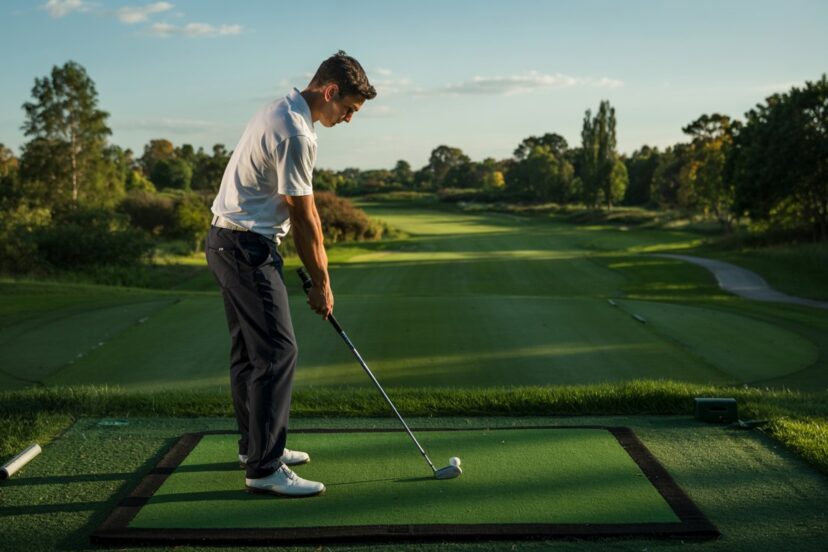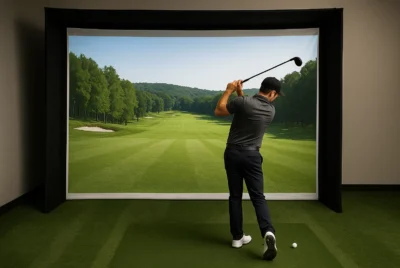The Ultimate Guide to Golf Hitting Mats
*We may earn a commission for purchases made using our links. Please see our disclosure to learn more.
I still remember the frustration of watching rain cancel my weekend practice sessions at the local driving range three weekends in a row. That was when I decided to invest in my first golf hitting mats. Seven years and countless swings later, I can confidently say it was one of the best decisions for my golf game. Not only has it helped me maintain consistency in my practice routine, but it’s also saved me hundreds in range fees.
In this comprehensive guide, I’ll share everything I’ve learned about selecting and using golf hitting mats, including my top product recommendations and practical tips to help you get the most from your practice sessions at home.
Key Takeaways:
- Quality matters: Investing in a durable, shock-absorbing mat prevents injury and provides realistic feedback.
- Size considerations: Choose a mat size that accommodates your full swing and stance.
- Surface texture: Look for mats that simulate real turf for the most authentic practice experience.
- Versatility: The best mats work with various clubs and can be used indoors or outdoors.
- Portability vs. permanence: Consider whether you need a permanent setup or something you can store away.
“The ability to practice consistently is the foundation of golf improvement. A quality hitting mat transforms any space into your personal training ground.”
– David Leadbetter, World-renowned golf instructor
Top Golf Hitting Mat Recommendations
After testing over twenty different models and consulting with teaching professionals, I’ve identified the four standout options for golf hitting mats currently available on Amazon:
1. GoSports Pro Turf Golf Hitting Mat
Train like a pro from the comfort of your home or backyard with the GoSports Golf Hitting Mat. Featuring commercial-grade synthetic turf and a thick, non-slip foam base, this 5’ x 4’ mat delivers a realistic feel and durability to handle up to 75,000 swings. Designed for right and left-handed golfers, it includes 3 rubber tees and six teeing positions, making it perfect for every club in your bag. Choose your style and elevate your game.
- Realistic Feel: Simulates real turf for a more authentic practice experience.
- Durable Design: Built to handle thousands of swings without wearing down.
- Versatile Use: Great for both indoor and outdoor settings with multiple teeing options.
- Price Point: Higher cost compared to basic mats.
- Heavy Weight: May be bulky for frequent transport or storage.
- Mat Thickness: Thicker foam may not suit golfers who prefer firmer feedback.
The GoSports 5’ x 4’ Pro Turf Golf Hitting Mat stands out as a durable, full-sized training mat designed for golfers who want a realistic feel during practice. Made with commercial-grade synthetic turf and a 15mm foam base, it offers a forgiving surface that mimics real fairway conditions while holding up to tens of thousands of swings.
What I love about it: The generous 5’ x 4’ size gives ample room for both right and left-handed golfers, with six teeing positions and three rubber tees included. The 15mm padded backing absorbs impact well and stays put on most surfaces, making it ideal for both indoor garage sessions and backyard practice. It’s clear this mat was designed by golfers, for golfers, with the durability and features to prove it.
What could be better: While the thicker foam is great for comfort, it may feel too soft for players who prefer a firmer strike surface, especially with irons. At 14 pounds, it’s a bit heavy to move around often, and storage might be awkward for those with limited space.
2. DURA-PRO Premium Golf Mat
The DURA-PRO Premium Turf Golf Mat delivers a pro-level training experience with its commercial-grade nylon surface and ultra-durable 30mm thickness. Whether you're practicing in your garage, backyard, or at a range, this mat is engineered to handle repeated high-impact swings from both irons and woods. It includes a bonus golf tray and three rubber tees for added value, making it a complete solution for golfers who demand quality and performance.
- Durability: Made with 100% nylon fiber and built to withstand intense, long-term use.
- Stability: Anti-slip foam backing keeps the mat firmly in place during powerful swings.
- Bonus Accessories: Comes with a golf tray and three rubber tees for added convenience.
- Price: Higher price point compared to basic residential mats.
- Weight: Heavier design may limit portability for some users.
- Firmness: Cushioning is robust but may feel too rigid for those seeking a softer feel.
For serious practitioners willing to invest in professional-grade equipment, the DURA-PRO Commercial mat stands out as exceptional. This 3′ x 5′ premium mat features 1.5″ thickness throughout and commercial-quality synthetic turf that closely replicates the feel and performance of natural grass.
What I love about it: The substantial construction absorbs impact impressively, significantly reducing stress on wrists, elbows, and shoulders during extended practice sessions. The turf composition allows clubs to interact naturally with the surface, providing authentic feedback on strike quality. Its durability is unmatched—I know several teaching professionals using these mats daily for over five years with minimal visible wear.
What could be better: The premium construction comes with a premium price tag that may exceed $300. Additionally, at 55 pounds, it’s not designed for frequent relocation. This is a mat that demands dedicated space.
3. Rukket Tri-Turf Golf Hitting Mat
The Rukket Tri-Turf Hitting Mat is a compact and effective training aid for golfers looking to improve their game at home. With three distinct surfaces—fairway, rough, and tight lie—it mimics real course conditions to sharpen your skills. This all-in-one kit includes 9 foam practice balls and 12 adjustable tees, making it a great value for beginners and seasoned players alike. Its foldable design and durable rubber base make it perfect for year-round, indoor or outdoor use.
- Multi-surface design: Offers fairway, rough, and tight lie turf for realistic practice.
- Great value: Includes practice balls and adjustable tees in one affordable package.
- Highly portable: Lightweight and foldable for easy setup anywhere.
- Small footprint: Limited size may not suit full-swing drivers.
- Foam balls only: Not ideal if you prefer using real golf balls.
- Basic padding: Cushioning is minimal compared to premium mats.
The Rukket Tri-Turf offering brings versatility in a highly portable package. Measuring 25″ x 16″, it’s among the most compact multi-surface options available, making it perfect for golfers with storage constraints or those who practice in different locations.
What I love about it: Despite its compact size, the mat doesn’t compromise on surface quality. The fairway section in particular provides a satisfying hitting experience. The included rubber tee holder accommodates various heights, making it surprisingly versatile for driver practice. The lightweight design and included carrying case make transportation effortless.
What could be better: The compact dimensions require more frequent repositioning during practice sessions. The backing, while adequate, doesn’t provide the stability of heavier options, occasionally requiring readjustment during intense sessions.
4. Real Feel Golf Mats Country Club Elite
Engineered for serious golfers, the Country Club Elite Mat by Real Feel delivers a premium, true-to-course experience. Its ultra-dense 110 oz nylon surface and commercial-grade foam backing simulate fairway conditions, allowing you to practice realistic down-and-through swings. Built tough for repeated use, it supports real wooden tees and offers unmatched durability. Whether indoors or outdoors, this mat gives you professional-grade feedback without leaving turf residue on your clubs.
- Takes real tees: Practice with wooden tees for authentic tee shots.
- True fairway feel: Dense turf mimics real course conditions for realistic feedback.
- Built to last: Heavy-duty, USA-made construction with exceptional shock absorption.
- Premium price: Higher cost may not suit casual golfers.
- Heavier mat: Less portable than lighter, more compact options.
- Turf stiffness: Might feel firmer than expected for beginners.
The Real Feel Country Club Elite represents the pinnacle of home practice surfaces. This premium mat employs proprietary fiber technology specifically designed to allow the club to cut through the turf similar to natural grass, providing unparalleled feedback quality.
What I love about it: The authentic feedback is invaluable, fat shots produce realistic results rather than the misleading bounce effect common with lesser mats. The fiber design significantly reduces shock transfer, making it exceptionally comfortable for high-volume practice. Durability is remarkable, with the manufacturer backing it with a 300,000-hit warranty.
What could be better: Excellence comes at a premium, expect to invest over $400 for standard sizes. The weight (approximately 70 pounds for the 3′ x 5′ model) makes it decidedly non-portable. This is an investment piece for dedicated practice spaces.
Understanding Golf Hitting Mats
Types of Golf Hitting Mats
The market offers several distinct types of golf hitting mats, each serving different needs and skill levels:
1. Standard flat mats represent the entry-level option for most golfers. These single-surface mats typically feature a uniform turf layer with a rubber backing. They’re straightforward, affordable, and get the job done for basic practice needs. Most include built-in tee holders, making them suitable for drivers and woods.
2. Tri-turf mats elevate your practice by providing multiple surfaces that replicate different course conditions. The typical configuration includes sections mimicking fairway, rough, and tee box surfaces. This variety allows you to practice adjusting to different lies without changing mats. For golfers serious about improvement, this versatility is invaluable for developing adaptability in your swing.
3. Commercial-grade mats are the premium option designed to withstand intense, frequent use. These are the same mats you’ll find at high-end driving ranges and teaching facilities. They feature thicker construction (usually 1-2 inches), superior shock absorption, and premium materials that closely mimic natural turf interaction. While expensive, they offer the most realistic practice experience and exceptional longevity.
4. Stance mats focus on providing stability for your entire body during the swing. These larger mats (typically 4′ x 5′ or larger) accommodate both your hitting area and stance. They’re essential for home simulator setups and help prevent the subtle shifts in body position that can occur when standing on a different surface than you’re hitting from.
5. Indoor/outdoor hybrid mats are specifically designed with weather resistance and versatility in mind. These mats often incorporate moisture-wicking materials and UV-resistant fibers to withstand various environmental conditions while maintaining performance consistency.
Material Quality and Durability
The materials used in golf hitting mats dramatically influence both performance and longevity:
- Nylon turf represents the budget-friendly option found in many entry-level mats. While reasonably durable for occasional use, nylon surfaces often create excessive club bounce, which can develop improper swing habits and potentially cause joint strain over time. These mats typically last 1-2 years with moderate use.
- Polyethylene turf strikes a balance between affordability and performance. This material provides improved durability over nylon and reduces the “bounce effect” somewhat. Mid-range mats using quality polyethylene can remain serviceable for 2-4 years of regular practice.
- Polypropylene fibers deliver the premium experience serious golfers seek. These specialized fibers are engineered to interact with golf clubs similarly to natural grass, allowing the clubhead to engage with the surface rather than bouncing off it. This interaction provides realistic feedback on fat shots and encourages proper technique. Premium mats using these materials often carry 5+ year warranties.
- Backing material serves as the foundation of the mat’s performance and durability. Dense rubber provides stability and prevents sliding during use. EVA foam offers superior shock absorption to protect your joints. The best mats combine multiple backing layers to optimize both stability and comfort.
- Infill materials are sometimes used in premium mats to further enhance performance. Materials like silica sand or crumb rubber are integrated into the turf fibers to add weight, stability, and a more realistic feel. These infill materials help the fibers remain upright and prevents matting down over time.
Size Considerations
Selecting the appropriate golf hitting mats sizes involves balancing practice needs with space constraints:
- Small mats (1′ x 2′ to 2′ x 2′) prioritize portability and storage convenience. They’re ideal for apartment dwellers or those with limited space. These compact options work well for basic practice and tee work but may require frequent repositioning for full swing practice.
- Medium mats (3′ x 4′ to 3′ x 5′) represent the sweet spot for most home users. They provide sufficient room for the hitting area while remaining manageable in terms of storage and transport. These dimensions accommodate most club types, though very tall golfers might find them somewhat restrictive.
- Large mats (4′ x 6′ or larger) offer the complete practice experience, accommodating your full stance and swing path. These professional-sized options are ideal for permanent installations and home simulator setups. They eliminate the need to stand on a different surface than you’re hitting from, creating a more consistent practice environment.
- Modular systems provide flexibility through interlocking sections that can be arranged according to your needs and available space. These systems allow you to start small and expand over time, which can be cost-effective for golfers unsure about their long-term practice space.
Getting the Most from Your Golf Hitting Mat
Proper Setup and Placement
Creating an effective practice environment starts with proper golf hitting mats placement:
- Surface stability is crucial for consistent practice. Place your mat on level ground to prevent subtle stance shifts that can affect your swing mechanics. Concrete provides ideal stability, but carpeted surfaces can work with anti-slip backing or mats with substantial weight.
- Swing clearance requires careful consideration, particularly for indoor setups. Measure your swing arc with your longest club (typically driver) and ensure adequate clearance on all sides. Remember to account for both backswing and follow-through heights.
- Orientation matters more than most golfers realize. Position your mat with your target line perpendicular to any nearby walls or obstacles. This arrangement provides the most natural visual alignment cues and minimizes the risk of developing directional biases in your practice.
- Light sources should ideally come from above or behind your stance rather than in your line of sight. Proper lighting eliminates shadows across your hitting area that can become visual distractions.
Maintenance Tips for Longevity
Protect your investment with these simple maintenance practices:
- Regular cleaning removes dirt and debris that can accelerate wear. For synthetic turf mats, a stiff brush removes embedded material without damaging fibers. For deeper cleaning, mild soap and water effectively remove stubborn residues—just ensure complete drying before storage.
- Rotation prevents uneven wear patterns. Most practice sessions concentrate impact in specific areas. Regularly rotating your mat distributes this wear more evenly, significantly extending its useful life.
- Proper storage preserves mat integrity when not in use. Store mats flat whenever possible, rolling or folding creates creases that may not fully recover. For mats that must be rolled, maintain a large diameter roll with the turf facing outward to minimize stress on the fibers.
- Temperature considerations matter for material longevity. Extreme temperatures can degrade backing materials and adhesives. While most mats tolerate moderate outdoor conditions, prolonged exposure to intense heat or freezing conditions accelerates deterioration.
Integrating Technology with Your Practice Mat
Modern technology can transform your mat into a complete practice system:
- Launch monitors provide data-driven feedback that dramatically accelerates improvement. Entry-level options like the Rapsodo Mobile Launch Monitor or Garmin Approach R10 pair effectively with home mats to provide metrics like ball speed, launch angle, and estimated distance.
- Practice nets or impact screens are essential companions for full-swing practice. Quality options from brands like The Net Return provide safe containment while allowing visual tracking of initial ball flight.
- Alignment aids complement your mat by promoting consistent setup. Simple alignment sticks or more sophisticated systems like the EyeLine Golf Alignment System help establish proper positioning relative to your target line.
- Video analysis adds valuable visual feedback to your practice routine. Position a smartphone camera directly behind or facing your setup to capture swing mechanics. Apps like V1 Golf or Hudl Technique allow frame-by-frame analysis of your movements.
Common Mistakes to Avoid
Choosing Based Solely on Price
While budget considerations are valid, selecting the absolute cheapest option typically leads to disappointment. Ultra-budget mats (under $50) generally feature thin construction with minimal shock absorption and poor turf quality. The resulting excessive club bounce not only provides misleading feedback but can contribute to joint stress and potential injury over time.
Better approach: Consider your mat as an investment in both your game and physical wellbeing. Allocate your budget to prioritize adequate thickness (minimum 5/8″) and turf quality that allows natural club interaction.
Neglecting Size Requirements
Many first-time buyers focus exclusively on the hitting area without considering their complete practice setup. This oversight often results in discovering that their mat doesn’t accommodate their stance comfortably, forcing them to stand on a different surface level than their hitting position.
Better approach: Measure your comfortable stance width with different clubs and ensure your mat choice either includes stance space or pair your hitting mat with a complementary stance mat of equal thickness.
Ignoring Surface Interaction
Different clubs interact with turf in distinct ways. Many mats perform adequately with irons but create unrealistic conditions for wedges that would normally take divots. This discrepancy can develop technique inconsistencies when transitioning back to natural turf.
Better approach: Select mats designed to allow some degree of turf interaction, particularly if short game practice is a priority. For budget constraints, consider specialized divot simulator attachments that can supplement standard mats.
Conclusion: Investing in Your Game
A quality golf hitting mat represents more than just a practice accessory, it’s an investment in consistency and improvement. By providing reliable access to practice regardless of weather or range availability, the right mat removes common barriers to regular skill development.
The ideal mat balances durability, realistic feedback, and physical comfort to create a practice environment that transfers effectively to on-course performance. While premium options deliver superior experiences, even moderately priced mats offer substantial benefits when selected with careful attention to your specific practice needs and physical requirements.
Remember that the perfect mat complements rather than replaces other practice modalities. The combination of mat practice, range sessions on natural turf, and on-course play creates the comprehensive development environment that leads to lasting improvement.
Whether you’re a competitive player seeking swing refinement or a recreational golfer working to break 90, the consistent practice enabled by a quality hitting mat can be the difference between frustration and achievement. Choose wisely, practice deliberately, and watch your game transform.
Frequently Asked Questions
1. Can practicing on mats damage my clubs?
Quality mats with adequate thickness pose minimal risk to modern clubs. However, mats with extremely firm surfaces or exposed hard backing can potentially accelerate wear on club faces. The most important factor is mat thickness—a minimum of 5/8″ provides sufficient cushioning for most swing types. Premium clubs with softer faces (particularly forged irons) may show accelerated wear with high-volume practice on firmer mats.
2. How long should a quality golf mat last?
Durability varies significantly based on construction quality and usage patterns. Entry-level mats typically remain serviceable for 1-2 years with moderate use (2-3 practice sessions weekly). Mid-range options generally perform well for 3-5 years under similar conditions. Premium commercial-grade mats often maintain their performance characteristics for 5+ years, even with intensive use. The first sign of deterioration is usually fiber matting or backing separation rather than complete failure.
3. Can I use real tees with my golf mat?
Most quality mats include designated tee holders that accommodate standard golf tees. Rubber tee holders typically accept wooden tees but may cause breakage with firm insertion. For mats without built-in holders, specialized rubber tees designed for mat use provide a superior alternative to forcing wooden tees through the turf surface, which can damage the backing over time.
4. Are golf mats suitable for all club types?
While versatile, not all mats perform equally with every club. Most perform admirably with mid-irons through wedges but may create unrealistic conditions for drivers (insufficient tee height) or wedges (inadequate turf interaction). Premium mats with appropriate thickness and fiber design offer the most consistent performance across the full club spectrum. For specialized short-game practice, consider dedicated chipping mats designed specifically for enhanced turf interaction.
5. Indoor vs. outdoor mats – is there a difference?
Dedicated outdoor mats incorporate UV-resistant fibers and weather-resistant backing to withstand environmental exposure. Indoor mats often prioritize realistic feel over weather resistance. While many mid-range and premium mats function adequately in both settings, prolonged outdoor exposure will accelerate degradation in mats not specifically designed for weather resistance. If your practice area transitions between indoor and outdoor settings, select mats with explicit outdoor durability ratings.
















